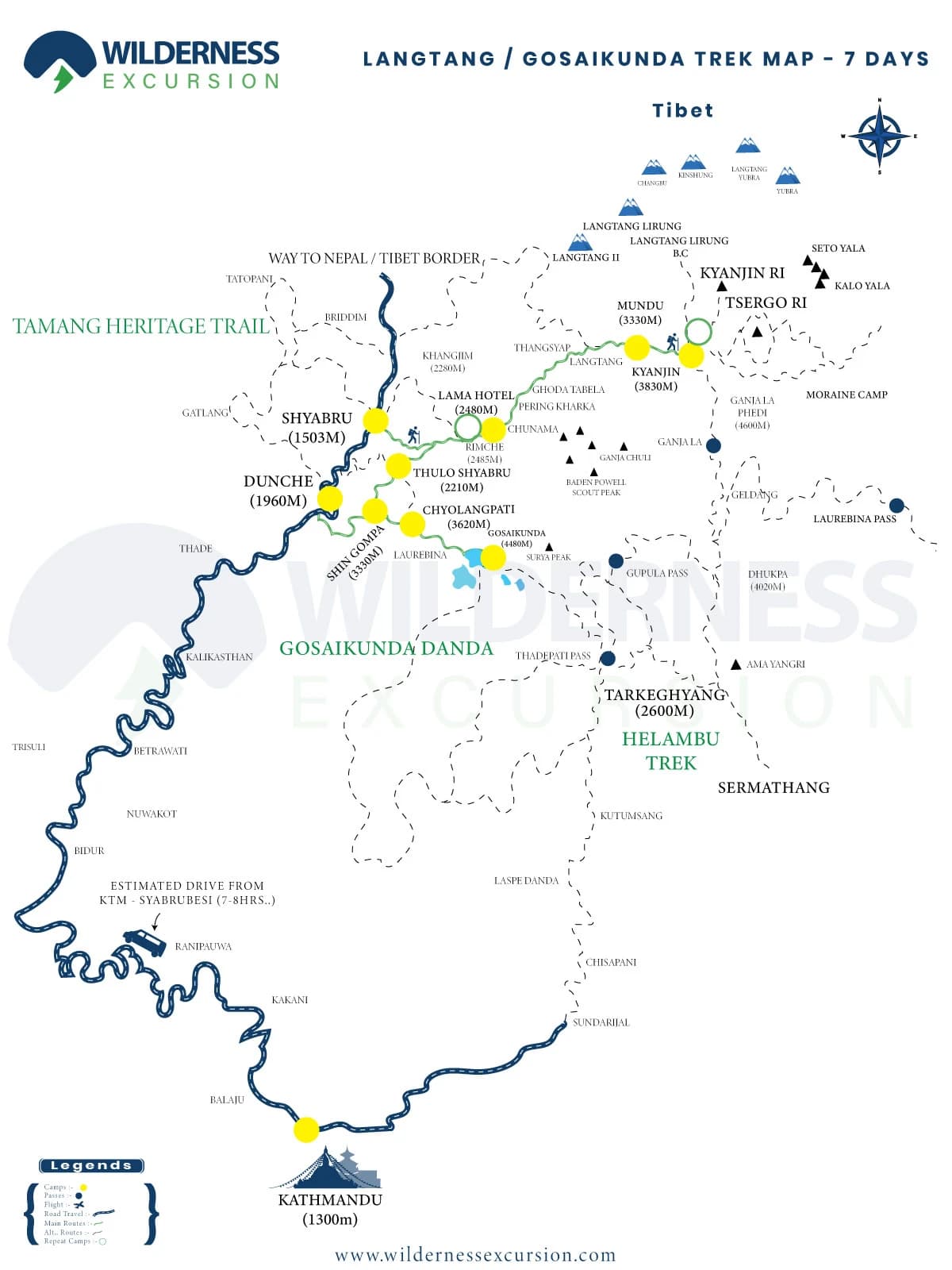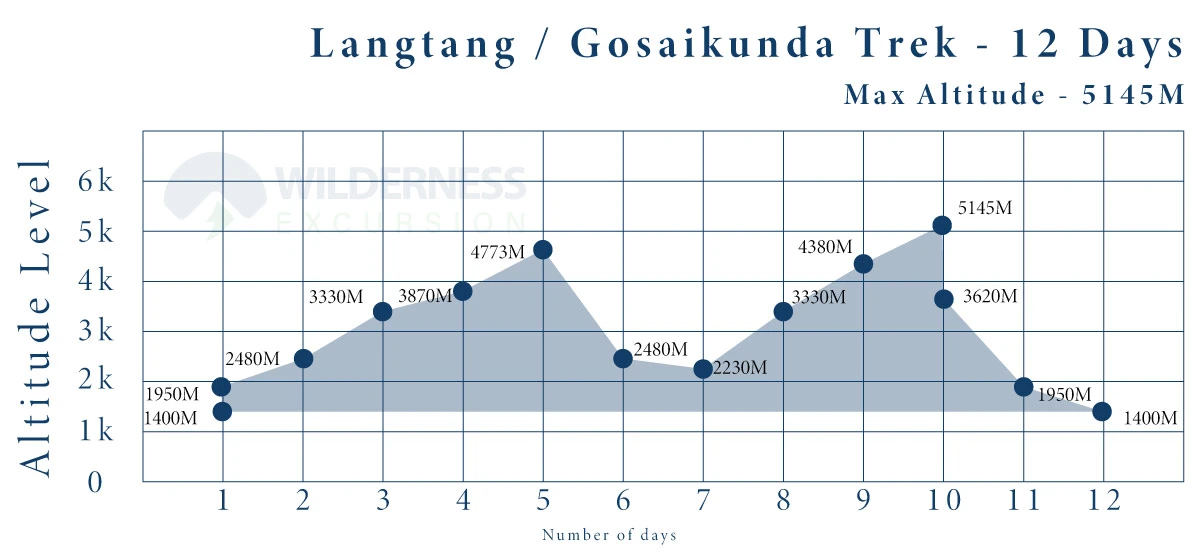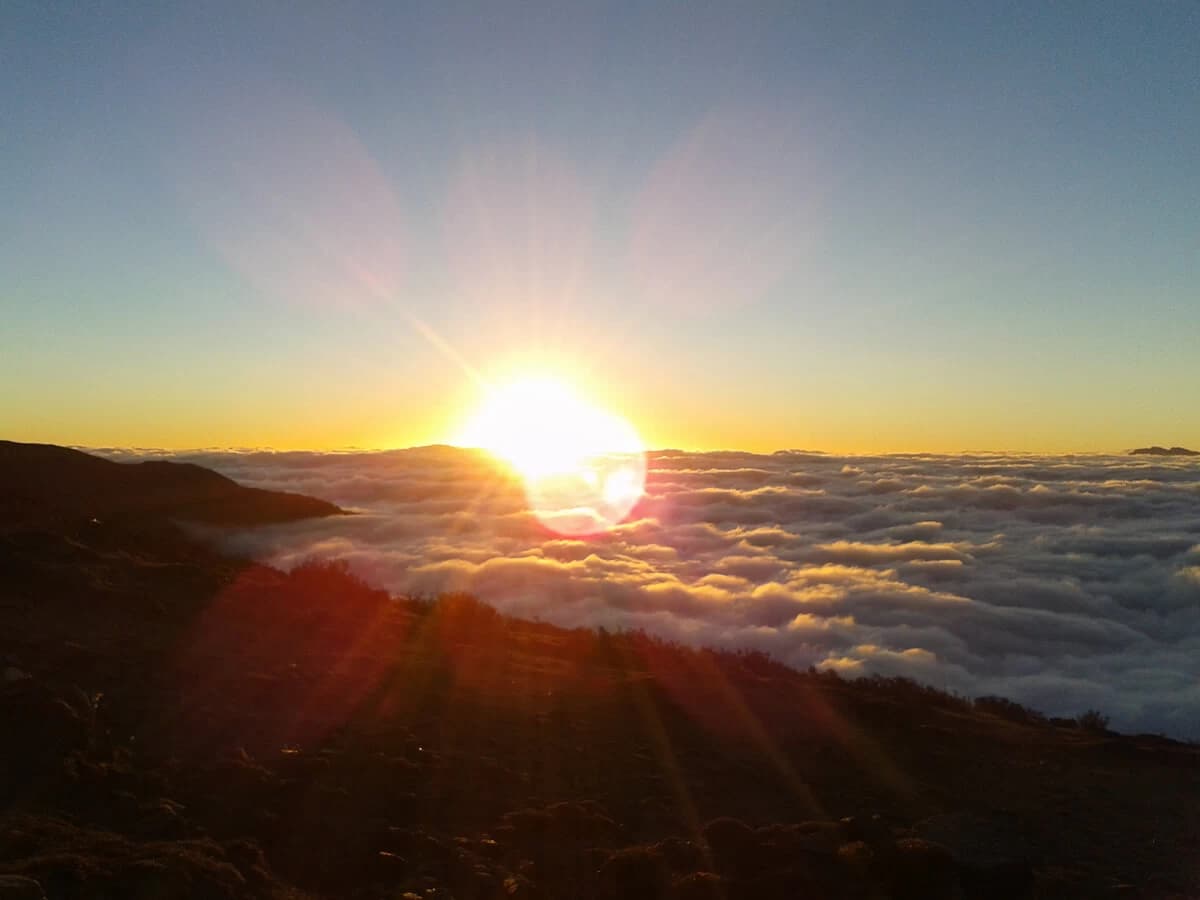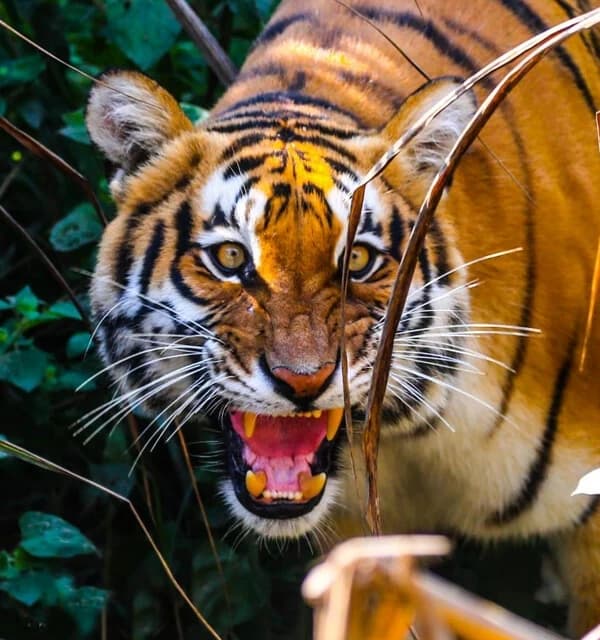The Langtang Gosaikunda Trek takes us on a beautiful journey in Nepal through lush forests, quaint villages, abundant wildlife, and astounding views of the majestic Himalayas to the high and isolated Langtang Valley, populated by hospitable and welcoming Tamang people and the sacred Lake of Gosaikunda.
Langtang Gosaikunda Trek - 12 Days
Langtang Gosaikunda Trek Overview
Langtang Gosaikunda Trek is a beautiful journey in Nepal through lush forests, quaint villages, abundant wildlife, and astounding views of the majestic Himalayas. The 12-day trek begins in Kathmandu, followed by a public bus ride to Syabrubesi, which is a Tamang village located on the banks of the Bhote Koshi River and begins our trek. We reach Kyanjin Gompa and then climb Tserko Ri the next day. From there we get tremendous views of the Langtang Lirung (7,200 m/23,622 ft) range. Next, we continue trekking in the beautiful Langtang Valley and reach Gosaikunda, which is a revered place of pilgrimage for both Buddhists and Hindus. Moreover, the place is named after the glistening Gosaikunda Lake, whose water is believed to have magical healing powers. We pass by a few more lakes on our trek and cross the Laurebina Pass. Our trek in the Helambu Valley begins after crossing the pass. Another highlight of our hike is reaching the top of Ama Yangri at 3,800 m. The view of the Himalayas from the top of the hill is believed to rival that of Poon Hill. From here, Mt. Shishapangma and the Langtang ranges seem so close that we feel that we can almost touch them. We continue trekking in the Helambu region for a few more days and end our remarkable journey to the mountains with a drive to Kathmandu.
Langtang Gosaikunda Trek takes us on a beautiful journey in Nepal through lush forests, quaint villages, abundant wildlife, and astounding views of the majestic Himalayas to the high and isolated Langtang Valley, populated by hospitable and welcoming Tamang people. Their religious practices, language, and dress are very similar to those of Tibet and to the traditions of their cousins in the middle hills. The area is famed for its pleasing local, exceptional tradition, Buddhist monasteries and monuments along the way, and spectacular mountain views. This charming Langtang valley trek with Holy Gosaikunda Lake follows the river upstream through pine, bamboo, and rhododendron forests, ascending through beautiful yak pastures to arrive at the alpine meadows of Kyanjin Gompa, where you will get an extraordinary mountain view just a stone’s throw from the Tibetan border. The Langtang Valley is easily accessible from Dhunche (the district headquarters of Rasuwa) town and the National Park Office, which is a day's drive from Kathmandu. The upper reaches of Langtang can be reached in four days of easy trekking; however, it is worthwhile to spend a few days around the forest at Ghoda Tabela to watch for the red panda. Once above Langtang village and the monastery at Kyangjin, Langtang is inhabited by people of Tibetan descent, whereas the villagers of Dhunche, Bharkhu, and Syabru further down are home to the Tamangs of Nepal's middle hills. Trekkers can explore the high valleys of Langshisa, Kyamjin Ri, and Chhirku Ri.
The forest around Ghode Tabela in the below Langtang Valley and lower Gosaikunda Lakes is inhabited by the very shy red panda, a rare and endangered symbol of a healthy Himalayan ecosystem. Other animals common to these forests are yellow-throated martens, wild boars, Himalayan black bears, ghoral (mountain goats), grey langur monkeys, and leopards. The region is also home to Himalayan honeyguides, mountain pheasants, musk deer, and snow leopards. The upper Langtang Valley is one of the few known breeding grounds of the ibis bills besides the Tibetan snowcock and snow partridge. Like other Himalayan nature parks, Langtang has to be explored on foot. There are several possible trails to choose from, depending on your favorite and the time available. Kindly write us for your customized trip itinerary, price, and trek map.
Major Highlights of Langtang Gosaikunda Trek:
- Discover the Tibetan culture and Tibetan mountain views with amazing glaciers and monasteries.
- Visit typical Tamang villages and their traditional cultures, but also the Langtang National Park and its wildlife, rhododendron forests, and nice tea houses.
- Homely hospitality. Walk alongside the holy lake Gosaikunda and observe the sunset and sunrise views in the mountains.
- Relax through peaceful forest walks and views of unlimited green valleys from Singgomba and taste the delicious local Yak cheese.
Your safety is our top priority when you trek with Wilderness Excursion. Please be aware that, in the event that safety considerations require it, your leader may change or cancel any portion of the itinerary if necessary.
After an early breakfast we drive north from Kathmandu to Syabru Besi. Parts of the road are unsealed and the condition of the road often depends upon the monsoon season. We will travel via Trisuli Bazaar where the dam and hydroelectric project was completed by the Indian Technical Mission. Finally we drive on to Syabrubesi and spend a night there. Stay overnight in lodge.
Start our trek after breakfast, the trail continues passing the village and you cross on a suspension bridge. Then the trail ascends upstream of Langtang Khola through the forests until reaching Pairo which takes about 3 hours. You have lunch break here. After lunch, your trek continues through the deep forests till Bamboo and it takes about 1 and half hour. Then the trail ascends through deep forests and you cross by suspension bridge, then again the steep ascent brings you in Lama Hotel which takes about 2 hours. Stay overnight in lodge.
The tail continues through the forests until reaching Gumnachok and it takes about 1 and half hour. Then you continue your hike to Godatabela which takes about 2 hours. Now you have a glimpse of Langtang Lirung. You have lunch break here. After lunch, the trail continues passing the yak pasture land and through the forests until reaching Thangshyap which takes about 2 hours. Then your trail keeps rising until Chyamki and it takes about 1 and half hour. You cross on a suspension bridge and continue till Langtang village which takes about 1 hour. . You have a good view of Langtang Lirung and other peaks as well as beautiful waterfall. You can visit old monastery with your guide in the evening time. Stay overnight in lodge.
Today is only short day walking from Langtang to Kyanjin Gompa. The trail continues passing the Yak pasture land until reaching Kyanjin Gompa which takes about 3 hours slowly. You have lunch. After lunch, you can visit Kyanjin Gompa and Cheese Factory with your guide and taste yak cheese. Now you have a superb view of Langtang Lirung, Gangchempu, Nayakhang and other peaks. Stay overnight in lodge.
Today, we do excursion and hike to Tsergo-Ri, 4985m. We start in the morning after breakfast. First you walk level trail about 30 minutes and you cross small stream. Then the trail continues steep ascending with viewing the panoramic snow capped mountains which takes about 3 and half hours. You have a superb view of Langtang Lirung, Nayakhang, Gangchembu, Ganja-La range, Yala peak, Langshisha Ri and other snowy peaks. If you want to explore more and spend long time on the top, you better to take packed lunch from your Lodge. After enjoying, you climb down till to lodge which takes about 2 and half hour. Stay overnight in lodge.
The trail descends down passing the yak pasture land until reaching Langtang which takes about 2 hours then continue walk and cross the suspension bridge and climb down till Thangshyap. It takes about 1 hour. Again you continue the trail following through the forests until reaching Godatabela which takes about 1 hour. You have lunch break here. After lunch, the trail keeps descending till Lama Hotel. Stay overnight in lodge.
We continue walking through the forests trail until reaching Pairo which takes about 3 hours. You have lunch break here. After lunch you skip the trail to Syabrubesi. You climb up steep trail until reaching Thulosyabru which takes about 2 hours. Now you have great view of mountains like Langtang Lirung, Ganesh Himal and other peaks. In the evening you can visit monastery with your guide. Stay overnight in lodge.
The trail is steep uphill until reaching Phoprang Danda at the height of 3190 meter; the place has best sun set view over Ganesh Himal and after lunch break there we continue passing through pleasurable uphill and blue pine forest via government agriculture office. Sing Gompa; also known as Chandan Bari. We can visit yak cheese factory there. Stay overnight in lodge.
After morning breakfast, we hike to Surya Peak (5145m) - a summit in the Langtang region of Nepal. Sitting just above Goisaikunda lakes, the peak is most often climbed as part of a visit to these high sacred lakes, where Lord Shiva is said to have thrust his trident into the ground creating the small alpine chain of lakes. Back to Gosaikumda and trek down to Cholangpati.
The holy lake, Gosainkunda has a black rock in the middle believed to be the head of Hindu God, lord Shiva. According to the legend, Shiva created the high altitude lake when he pierced the glacier with trident to get water to quench his thirst after consuming poison gathered from the churning of the ocean. The white rock under water is said to be the remnant of an ancient Shiva shrine. It is also believed that the water from the lake disappears underground via a subterranean channel and surfaces in Kumbheswor pool, next the five-storey Shiva temple in Patan. The place famous pilgrimage site of Hindus and hundreds of people visit the site to worship during Janai Purnima festival (Full moon night, which falls in August). The place is said to have 108 lakes including Gosainkund, Saraswati Kunda, Bhairav Kunda, Nag Kunda, Dudh Kunda, Chandra Kunda and Mother Kunda etc. in addition, we can hike up to Lauribina La (4610m) or explore some other view point for the day hike. Stay overnight in lodge
Trek to Dhunche Village is all the way down via Lauribinayak, Chandan Bari then cross Trishuli Khola to make to Dhunche. Stay overnight in lodge.
In the morning after breakfast, drive from Dunche to Kathmandu by private vehicle. It takes about 5-6 hours to Kathmandu by jeep. We have lunch break in Trisuli. After lunch, the road is smooth till Kathmandu. Transfer to selected Hotel.
This is our standard itinerary. It can be customized or slightly changed if required considering your pace and trekking habit that cause a change of day-to-day plan.


- An experienced expert Langtang Gosaikunda Trek guide.
- One porter between two trekkers to carry your main pack (weight limit 25 kg)
- Meals: 11 breakfasts, 12 lunches, and 11 dinners during the trek.
- Three cups of tea every day.
- Round-trip ground transportation by public bus.
- Sharing trekking lodge accommodation on a double occupancy basis.
- Guide and porter wages, with all their expenses, during the activity
- Langtang Valley Gosaukunda Trek Permission.
- Taxes and documentation fees.
- Pre-trek and post-trek accommodations and meals in Kathmandu.
- Guided sightseeing and monuments entrance fees in Kathmandu
- Bar and beverages such as Coke, Fanta, mineral water, beer, etc.
- Hot shower, laundry, toiletries, etc.
- Personal hiking gear and travel insurance.
- Rescue operation fee in case of emergency
- Tip your guide/porter.
Check our dates published to see if it matches your time. We are happy to customize your tour perfectly to match your interests and needs, creating a unique travel experience just for you
For customized trek package as per your interest; please kindly provide us details like group size, nationality, mode of hotels in Kathmandu and vehicles you would like to use. The price we have offered online includes 3 nights deluxe twin/double room with breakfast in 3 star category boutique hotel in Kathmandu. International Tour Leader are encourage to get complimentary or discounted rate.
It was a great to work with Pradip to tailor a trip up Langtang and Gosaikunda Trek. I threw many questions and options at him and he always got back promptly and with a can do attitude. The actual trek...
The trekking have been dherai ramro cha! And our guide Rabi makes you feel sure and capable to do it! He was always taking care of everything. Have been and amazing trekking! Dhanyabad!!!
Great second trek in Nepal!
I just completed the Langtang Valley Trek with a side trek to Gosaikunda. It was a great moment in Nepal again for a solo female trekker from Thailand; I spent 12 days in Langtang Himal...






